Collection Letters To Patients
Subject: Outstanding Balance and Payment Reminder
Dear [Patient's Name],
I hope this letter finds you in good health. We appreciate your trust in our healthcare services and wanted to reach out to you regarding an outstanding balance on your account.
According to our records, there is an unpaid balance of $[Amount] for the medical services provided to you on [Date(s)]. We understand that managing medical expenses can be challenging, and we want to ensure that you are aware of this balance and provide you with the opportunity to settle it.
We kindly request that you take the time to review your records and arrange for payment as soon as possible. We accept various payment methods, including:
1. Credit card payment: You can call our billing department at [Phone Number] to provide your credit card details securely over the phone.
2. Online payment: Visit our website at [Website URL] and navigate to the "Billing" or "Payment" section to make a payment online. Our website provides a secure platform for online transactions.
3. Mail-in payment: If you prefer to send a check or money order, please make it payable to [Your Name or Organization] and mail it to the address mentioned above. Please include your account number or invoice number on the memo line to ensure accurate processing.
If you have any questions or concerns regarding the balance or need assistance with setting up a payment plan, please do not hesitate to contact our billing department at [Phone Number]. Our dedicated team will be happy to assist you and address any queries you may have.
We understand that circumstances can arise, leading to difficulties in paying off medical bills promptly. If you are facing financial challenges, we encourage you to discuss your situation with our billing department. They can provide information about potential financial assistance programs or work with you to establish a suitable payment arrangement.
Please note that failure to address this outstanding balance may result in further collection efforts, including the involvement of a third-party collection agency. We aim to avoid such measures and hope to resolve this matter amicably.
Thank you for your prompt attention to this matter. We value your partnership and look forward to continuing to serve your healthcare needs. If you have already made a payment, please disregard this letter.
Warm regards,
[Your Name]
[Your Title/Position]
[Your Organization]
[Phone Number]
[Email Address]
First Reminder - Friendly Tone
Subject: Friendly Reminder About Your Account Balance
Dear [Patient Name],
We hope this message finds you well and that you're feeling better after your recent visit to our office on [Date].
We wanted to reach out regarding your account balance of $[Amount] for services rendered on [Date]. We understand that managing medical bills can sometimes be overlooked among life's many responsibilities.
If you've already sent your payment, please disregard this message, and thank you! If not, we'd appreciate it if you could submit payment at your earliest convenience. We offer several payment options including online payment through our patient portal, payment by phone, or mailing a check to our office.
If you have any questions about your bill or would like to discuss payment arrangements, please don't hesitate to contact our billing department at [Phone Number]. We're here to help make this process as easy as possible for you.
Thank you for choosing our practice for your healthcare needs. We look forward to continuing to serve you.
Warm regards,
[Practice Name]
Billing Department
[Contact Information]
Second Notice - Professional Tone
Subject: Second Notice - Outstanding Balance on Your Account
Dear [Patient Name],
This is a follow-up to our previous communication dated [Date] regarding the outstanding balance of $[Amount] on your account for services provided on [Date].
According to our records, we have not yet received payment for the above-mentioned amount. We understand that circumstances can sometimes delay payment, and we want to work with you to resolve this matter.
Please remit payment within 15 days of receiving this notice. If you're experiencing financial difficulties, we encourage you to contact our billing office at [Phone Number] to discuss possible payment plan options. We offer flexible arrangements to help make your healthcare expenses more manageable.
Payment can be made through:
- Online via our patient portal at [Website]
- By phone at [Phone Number]
- By mail to [Mailing Address]
- In person at our office during business hours
If you believe this balance has been paid or if there's an error in our records, please contact us immediately so we can resolve any discrepancies.
Your prompt attention to this matter is greatly appreciated. We value you as a patient and look forward to continuing to provide you with excellent care.
Sincerely,
[Practice Name]
Billing Department
[Contact Information]
Third Notice - Serious Tone
Subject: URGENT - Third Notice of Outstanding Balance
Dear [Patient Name],
This is our third attempt to contact you regarding the overdue balance of $[Amount] on your account. Despite our previous notices dated [Date 1] and [Date 2], we have not received payment or heard from you regarding this matter.
The outstanding balance relates to services provided on [Date] and is now [Number] days past due. Immediate payment is required to prevent further collection action on your account.
We must receive payment or hear from you within 10 days of the date of this letter. If we do not receive payment or establish a payment arrangement by [Specific Date], we will have no choice but to take the following actions:
- Report this delinquent account to credit reporting agencies, which may negatively impact your credit score
- Forward your account to a third-party collection agency
- Restrict future services to emergency care only until the balance is resolved
We genuinely want to avoid these measures. If you're unable to pay the full amount, please contact our billing office immediately at [Phone Number] to arrange a payment plan. We are willing to work with you, but we must hear from you right away.
This is a serious matter that requires your immediate attention. Please do not ignore this notice.
Sincerely,
[Practice Name]
Billing Department
[Contact Information]
Payment Plan Acceptance Letter
Subject: Payment Plan Approved for Your Account
Dear [Patient Name],
Thank you for contacting our billing department to discuss your outstanding balance. We're pleased to confirm that we have approved a payment plan for your account.
Payment Plan Details:
Total Amount Owed: $[Amount]
Monthly Payment: $[Amount]
Number of Payments: [Number]
First Payment Due: [Date]
Subsequent Payment Dates: [Day] of each month
Your payments can be made through automatic monthly deductions from your bank account or credit card, or you may submit manual payments each month via our patient portal, by phone, or by mail.
Please note that this payment plan is contingent upon making each payment on time. If a payment is missed or returned for insufficient funds, the entire remaining balance may become due immediately, and your account may be subject to collection procedures.
We appreciate your commitment to resolving this balance and your continued trust in our practice. If you have any questions or if your financial situation changes, please contact us immediately at [Phone Number].
Thank you for your cooperation.
Best regards,
[Practice Name]
Billing Department
[Contact Information]
Insurance Pending Letter
Subject: Update on Your Account - Insurance Processing Delay
Dear [Patient Name],
We're writing to update you on the status of your account for services received on [Date].
We submitted a claim to your insurance carrier, [Insurance Company Name], on [Date]. However, we have not yet received payment or a response from them. This delay may be due to various reasons such as additional information requirements, claim review processes, or administrative backlogs.
Current Status:
- Total charges: $[Amount]
- Insurance claim submitted: [Date]
- Days pending: [Number]
At this time, no payment is required from you. We are actively following up with your insurance company and will continue to do so until we receive a response. We will contact you immediately if your insurance company determines that you owe a deductible, co-payment, or any portion of the balance.
If you have any information about your insurance coverage or if you've had any communication with your insurance company regarding this claim, please contact our billing office at [Phone Number]. Sometimes patient inquiries can help expedite the claims process.
We appreciate your patience as we work through this insurance matter. Rest assured that we are committed to resolving this as quickly as possible.
If you have any questions, please don't hesitate to reach out.
Sincerely,
[Practice Name]
Billing Department
[Contact Information]
Patient Responsibility After Insurance Letter
Subject: Your Responsibility After Insurance Processing
Dear [Patient Name],
We have received a response from your insurance company regarding the services you received on [Date]. Your insurance has processed the claim, and we're writing to inform you of your remaining responsibility.
Account Summary:
Total Charges: $[Amount]
Insurance Payment: $[Amount]
Insurance Adjustment: $[Amount]
Your Responsibility: $[Amount]
Explanation:
Your insurance company has applied $[Amount] toward your deductible and/or determined that $[Amount] is your co-insurance responsibility based on your policy benefits. This amount is now due from you.
The enclosed Explanation of Benefits (EOB) from your insurance company provides detailed information about how they processed this claim. If you have questions about what your insurance covered or why you owe this amount, we recommend contacting your insurance company directly at the customer service number on your insurance card.
Payment is due within 30 days. You may pay online through our patient portal, by phone at [Phone Number], by mail, or in person. If you need to arrange a payment plan, please contact our billing office.
Thank you for your prompt attention to this matter.
Sincerely,
[Practice Name]
Billing Department
[Contact Information]
Final Notice Before Collections
Subject: FINAL NOTICE - Account to be Forwarded to Collections
Dear [Patient Name],
This is your FINAL NOTICE regarding the seriously delinquent balance of $[Amount] on your account.
Despite multiple previous attempts to contact you (dated [Date 1], [Date 2], and [Date 3]), your account remains unpaid and is now [Number] days past due.
IMMEDIATE ACTION REQUIRED: You have 7 days from the date of this letter to either pay your balance in full or contact our office to make payment arrangements. If we do not receive payment or hear from you by [Specific Date], your account WILL be forwarded to [Collection Agency Name] for collection.
Consequences of Collection Action:
- This debt will be reported to major credit bureaus and will negatively impact your credit score
- You may be charged additional collection fees and interest
- Collection agencies may pursue legal action to recover the debt
- Future services at our practice will be limited to emergency care only
This is your last opportunity to resolve this matter directly with our office and avoid collection proceedings. We strongly urge you to take immediate action.
To make a payment or discuss this urgent matter, contact our billing department immediately at [Phone Number].
Time is of the essence. Please do not delay.
[Practice Name]
Billing Department
[Contact Information]
FINAL NOTICE - IMMEDIATE ACTION REQUIRED
Account Sent to Collections Notification
Subject: Notice - Your Account Has Been Forwarded to Collections
Dear [Patient Name],
This letter is to inform you that your account with an outstanding balance of $[Amount] has been forwarded to our collection agency, [Collection Agency Name], for collection.
Despite our repeated attempts to resolve this matter directly with you, including notices dated [Date 1], [Date 2], [Date 3], and [Date 4], we received no payment or response regarding your overdue balance.
Effective [Date], [Collection Agency Name] is now handling all collection activities for this account. All future correspondence and payments regarding this debt should be directed to them at:
[Collection Agency Name]
[Address]
[Phone Number]
[Email/Website if applicable]
Please note:
- Our office is no longer handling this account for payment purposes
- This account has been reported to credit reporting agencies
- You should contact the collection agency directly to resolve this matter
- Future appointments at our practice will be limited to emergency services until this matter is resolved
If you believe this account has been forwarded to collections in error or if you have documentation of payment, please contact the collection agency immediately with proof of payment.
We regret that we had to take this action. Should you resolve this matter with the collection agency, we would be happy to welcome you back as a regular patient.
[Practice Name]
[Contact Information]
What Are Collection Letters to Patients and Why Are They Necessary
Collection letters are formal communications sent by healthcare providers to patients who have outstanding balances on their accounts. These letters serve as reminders and notices about unpaid medical bills and request payment or communication regarding the debt. They are essential tools in medical billing that help practices maintain financial stability while preserving patient relationships. The primary purposes include: recovering revenue for services already provided, maintaining clear communication about financial obligations, providing patients opportunities to resolve balances before more serious collection actions, documenting attempts to collect payment for legal and regulatory compliance, and offering patients options like payment plans when they face financial hardship.
When Should Collection Letters Be Sent to Patients
Collection letters should be sent according to a systematic timeline that escalates appropriately:
- Initial statement: Sent immediately after services are rendered (Day 0-7)
- First reminder: Sent 30 days after the initial statement if no payment received
- Second notice: Sent 60 days after services if balance remains unpaid
- Third notice: Sent 90 days after services with more serious tone
- Final notice: Sent 120 days after services, warning of imminent collection action
- Collections notification: Sent when account is forwarded to collections agency
Additional scenarios that trigger collection letters include: when insurance denies a claim and patient responsibility is determined, when a patient's payment plan payment is missed, when a returned check or declined credit card requires follow-up, when a patient disputes a charge but has not provided documentation, or when a patient has requested an itemized bill and payment deadline has passed.
Who Should Send Collection Letters to Patients
Collection letters should appear to come from legitimate, authorized personnel within the healthcare organization:
- Billing department manager or director: Most appropriate for standard collection letters as they oversee the revenue cycle
- Practice administrator or office manager: Suitable for smaller practices where billing is handled in-house
- Physician or practice owner: Reserved for final notices or when the relationship requires personal attention
- Third-party billing company: If outsourced billing is used, letters may come from that company on behalf of the practice
- Collections attorney: Only for accounts that have moved to legal action
The sender should have the authority to offer payment plans, make account adjustments, or take collection actions. Letters should always include the name, title, phone number, and email of a specific contact person who can address patient concerns.
To Whom Should Collection Letters Be Addressed
Collection letters must be addressed to the legally responsible party:
- Adult patients: Letters go directly to the patient who received services (age 18+)
- Parents or legal guardians: For patients under 18, letters are addressed to the parent/guardian responsible for the account
- Guarantors: For accounts where someone other than the patient guaranteed payment
- Estate representatives: When a deceased patient's estate owes a balance, letters should be addressed to the executor or estate administrator
- Power of attorney holders: If a patient has granted financial power of attorney, correspondence may need to go to that individual
- Married couples: In community property states, both spouses may be responsible; verify state laws
Always verify the correct responsible party before sending collection letters, especially in cases of divorce, separation, or complex family situations. Sending to the wrong party can create legal issues and HIPAA violations.
Requirements and Prerequisites Before Sending Collection Letters
Before initiating collection correspondence, ensure the following conditions are met:
- Verify accuracy: Confirm the balance is correct and all payments, insurance adjustments, and credits have been applied
- Insurance exhausted: Ensure all insurance claims have been filed, processed, and appealed if necessary
- Contact information current: Verify you have accurate mailing address, phone number, and email
- HIPAA compliance: Ensure letter content complies with HIPAA privacy regulations and doesn't disclose protected health information
- State and federal laws: Review compliance with Fair Debt Collection Practices Act (FDCPA) and state-specific collection laws
- Documentation: Maintain records of all statements and communications sent to the patient
- Payment history review: Check for any recent payments that may have been made but not yet posted
- Dispute resolution: Address any billing disputes or questions before sending collection notices
- Authorization: Ensure appropriate personnel have approved the collection process for the account
- Practice policy review: Confirm the collection timeline and procedures align with practice policies
How to Write and Send Collection Letters to Patients
The process of creating and sending effective collection letters involves several key steps:
Planning and Strategy:
- Establish a consistent collection timeline and stick to it for all accounts
- Create templates for each stage of the collection process
- Determine which accounts warrant different approaches based on balance size or patient history
Writing the Letter:
- Begin with clear identification of the patient and account details
- State the purpose immediately and directly
- Include specific information: date of service, amount owed, days past due
- Use progressively firmer language as the collection timeline advances
- Always provide multiple payment options and contact information
- Maintain professionalism regardless of frustration
Review Process:
- Have a second person review letters for accuracy before sending
- Verify all amounts, dates, and contact information are correct
- Ensure compliance with legal requirements and practice policies
Sending Methods:
- First notices typically sent via email or regular mail
- Later notices should be sent via certified mail with return receipt
- Maintain copies of all correspondence in the patient's account
- Track when letters are sent and received for documentation
Follow-up:
- Document all collection activities in the patient account
- Set reminders for next steps if no response is received
- Be prepared to respond to patient inquiries promptly
Formatting Guidelines for Collection Letters to Patients
Proper formatting enhances the effectiveness and professionalism of collection letters:
Length: Keep letters concise—typically one page or less. First reminders can be brief (3-4 paragraphs), while later notices may need additional detail.
Tone Progression:
- First notice: Friendly, assuming simple oversight
- Second notice: Professional and straightforward
- Third notice: Firm but still respectful
- Final notice: Serious and urgent, clearly stating consequences
Structure Requirements:
- Clear subject line indicating the letter's purpose
- Professional greeting using patient's preferred name
- Account information prominently displayed
- Action items clearly stated with specific deadlines
- Multiple contact methods provided
- Professional closing with signature
Style Considerations:
- Use clear, plain language avoiding medical jargon
- Avoid accusatory or threatening language that could damage relationships
- Include specific dollar amounts, dates, and deadlines
- Use bullet points for account summaries or payment options
- Bold or highlight critical information like due dates or final notice warnings
Mode of Delivery:
- Email for initial reminders (faster and more convenient)
- Printed letters for second and subsequent notices (more formal)
- Certified mail for final notices and legal documentation
- Never discuss account details via text message or social media
What to Do After Sending Collection Letters
Follow-up actions are crucial to the collection process:
Immediate Actions:
- Document the date and method of sending in the patient's account
- Set calendar reminders for follow-up dates
- Update account status to reflect current collection stage
- Prepare for potential patient responses or inquiries
Monitoring:
- Check daily for payments received via mail, online portal, or phone
- Review email and voicemail for patient responses
- Track certified mail return receipts
- Monitor for any returned mail indicating incorrect addresses
Response Handling:
- Return all patient calls within 24 hours
- Be prepared to explain charges, offer payment plans, or address disputes
- Document all conversations in the patient account
- Send written confirmation of any payment arrangements made
Timeline Management:
- If no response received within specified timeframe, send next level notice
- Don't skip steps or rush the timeline—consistency is important
- Consider calling patients between written notices for high-balance accounts
Escalation Decisions:
- Review accounts that reach final notice stage with management
- Determine whether to forward to collections or write off
- Ensure all required attempts have been made before external collection
- Consider patient relationship, balance amount, and collection probability in decisions
Record Keeping:
- Maintain comprehensive documentation of all collection efforts
- Keep copies of all letters sent and received responses
- Record all phone conversations with detailed notes
- Preserve documentation for potential legal proceedings or audits
Advantages and Disadvantages of Sending Collection Letters
Advantages:
- Provides systematic, professional approach to collecting unpaid balances
- Creates written documentation of collection attempts for legal protection
- Offers patients multiple opportunities to resolve balances before serious consequences
- Maintains higher recovery rates than skipping directly to collections agencies
- Allows practices to retain control over the collection process and patient relationship
- Gives patients options like payment plans that benefit both parties
- Less expensive than immediately using third-party collectors
- Preserves patient relationships better than aggressive collection tactics
Disadvantages:
- Time-consuming process requiring staff resources and attention
- May damage patient relationships if not handled with appropriate sensitivity
- Not all letters result in payment, leading to wasted effort on some accounts
- Delays ultimate recovery if the account eventually goes to collections anyway
- Postage and printing costs add up for physical letters
- Patients may become angry or defensive, creating difficult interactions
- Risk of legal issues if letters don't comply with collection laws
- May be ignored by patients who have no intention of paying
Common Mistakes to Avoid When Sending Collection Letters
Compliance Errors:
- Violating HIPAA by including too much medical information in letters
- Not complying with Fair Debt Collection Practices Act regulations
- Sending letters to wrong responsible parties
- Failing to include required disclosure statements
Communication Mistakes:
- Using threatening, abusive, or unprofessional language
- Making empty threats about actions you won't actually take
- Sending inconsistent or confusing messages across multiple notices
- Failing to provide clear contact information and payment options
Process Failures:
- Sending collection letters before insurance has been properly processed
- Not verifying balance accuracy before sending notices
- Skipping steps in the collection timeline
- Sending letters too frequently or too infrequently
- Not documenting collection activities properly
Content Issues:
- Including inaccurate dates, amounts, or account information
- Being too vague about what actions will be taken
- Not providing specific due dates or deadlines
- Forgetting to include payment plan options
- Making the letter too long or difficult to understand
Relationship Damage:
- Being too aggressive too early in the collection process
- Not listening to or acknowledging patient financial hardships
- Refusing to work with patients who are trying to resolve balances
- Treating all patients the same regardless of their situation or history
Comparing Collection Letters to Alternative Collection Methods
Collection Letters vs. Phone Calls:
- Letters provide written documentation while calls may be forgotten or disputed
- Phone calls allow immediate two-way communication and quicker resolution
- Letters are less intrusive but easier to ignore
- Combination approach is often most effective
Collection Letters vs. Direct Collections Agencies:
- In-house letters maintain patient relationships while agencies are more aggressive
- Letters cost less but may recover less money
- Agencies have legal resources and expertise practices may lack
- Letters allow practice to control process; agencies take over completely
Collection Letters vs. Small Claims Court:
- Letters are faster and less expensive than legal action
- Court action is public record which may be more motivating
- Court judgments are enforceable but require significant time and effort
- Letters should always precede legal action
Collection Letters vs. Online Patient Portals:
- Portal statements are convenient but may lack urgency of formal letters
- Letters provide escalating tone that portal messages typically don't
- Portals allow instant payment but depend on patient logging in
- Best practice uses both methods in coordination
Collection Letters vs. Text/Email Only:
- Formal letters carry more weight and seriousness than electronic-only communication
- Electronic methods are faster and cheaper
- Physical letters provide better legal documentation
- Certified mail proves delivery unlike emails
Tips and Best Practices for Effective Collection Letters
Timing Strategies:
- Send first notice quickly after due date to establish expectations
- Maintain consistent intervals between notices (typically 30 days)
- Send letters early in the month when patients may have more funds available
- Avoid sending during major holidays when mail may be delayed
Communication Techniques:
- Personalize letters with patient names and specific account details
- Always assume positive intent in early letters—people forget or make mistakes
- Offer specific solutions like payment plans rather than just demanding payment
- Include success stories like "90% of patients resolve their balances within 60 days"
Operational Excellence:
- Automate letter generation where possible to ensure consistency
- Use templates but customize when appropriate for unique situations
- Train staff thoroughly on collection policies and communication skills
- Review collection letter effectiveness quarterly and adjust approaches
Relationship Preservation:
- Emphasize continued commitment to providing excellent care
- Acknowledge that medical bills can be confusing and offer to explain charges
- Show willingness to work with patients experiencing financial hardship
- Keep tone respectful throughout entire process
Legal Protection:
- Consult with healthcare attorney to review letter templates
- Include proper disclosures required by federal and state law
- Never make threats you don't intend to follow through on
- Maintain meticulous records of all collection correspondence
Efficiency Improvements:
- Use certified mail only when legally necessary—it's expensive
- Consider email for early notices to save time and money
- Implement online payment options and promote them in every letter
- Batch process letters to maximize staff efficiency
Essential Elements and Structure of Collection Letters
Every collection letter should include these critical components:
Header Information:
- Practice name, address, and logo for official appearance
- Date of letter
- Patient name and address
- Account or patient ID number
Subject Line:
- Clear indication of letter purpose
- Account reference or balance amount
- Urgency indicator for later notices (e.g., "FINAL NOTICE")
Opening/Greeting:
- Professional salutation using patient's preferred name
- Brief acknowledgment of patient relationship when appropriate
Body Content:
- Statement of account balance owed
- Date(s) of service rendered
- Number of days past due
- Summary of previous collection attempts (for later notices)
- Specific deadline for payment or response
- Consequences of non-payment (for later-stage letters)
- Available payment options and methods
Payment Information:
- Multiple ways to make payment (online, phone, mail, in-person)
- Specific contact information for billing questions
- Payment plan availability mention
Closing:
- Professional sign-off
- Signature of appropriate staff member
- Printed name and title
- Department contact information
- Billing office phone number and hours
Required Attachments (when applicable):
- Copy of original itemized statement
- Insurance Explanation of Benefits (EOB)
- Payment plan agreement forms
- Return envelope for mailed payments
Legal Disclosures (when required):
- Mini-Miranda warning for collection agencies
- Credit reporting notification
- State-specific collection disclosures

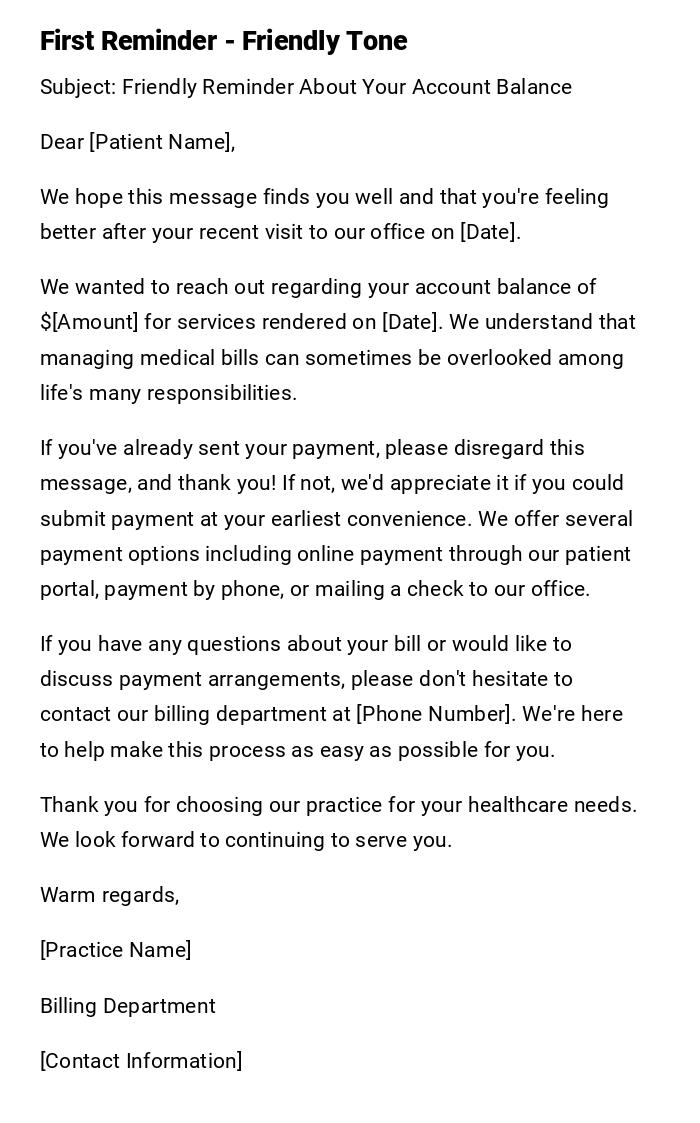
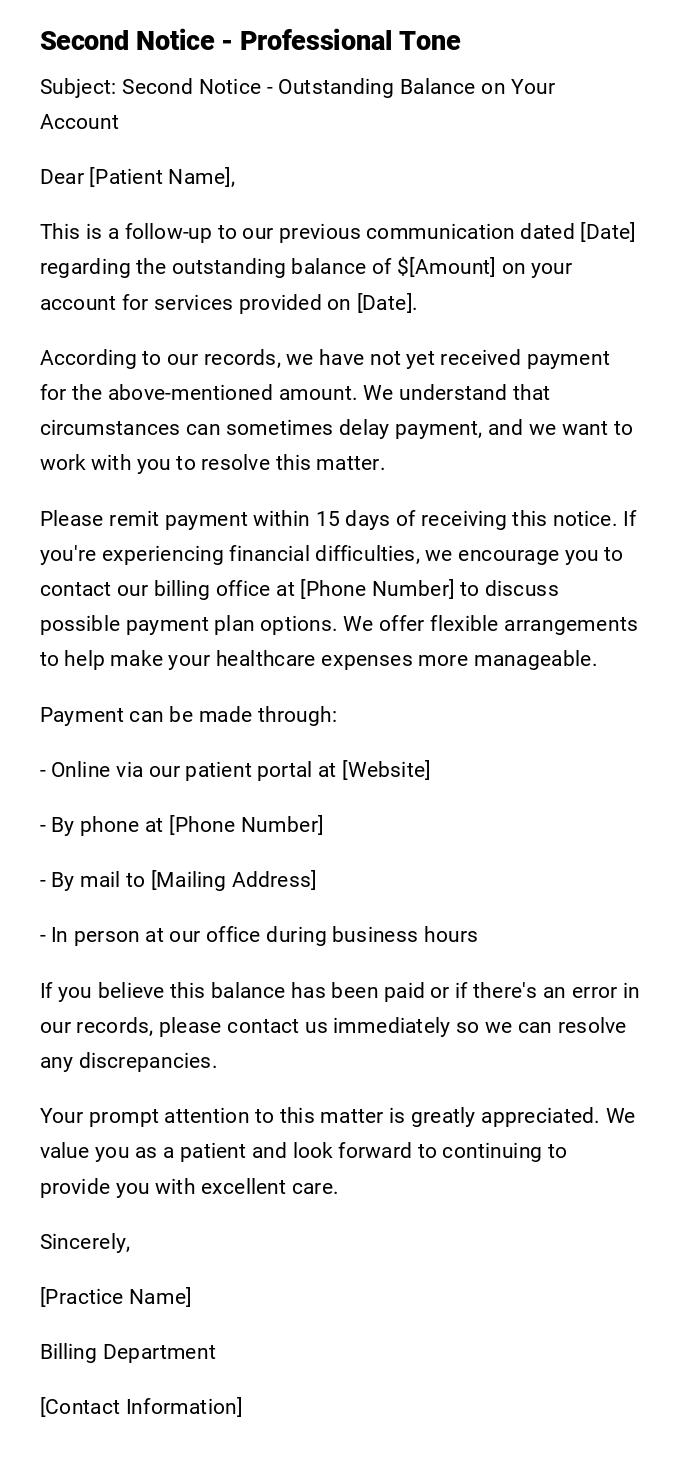

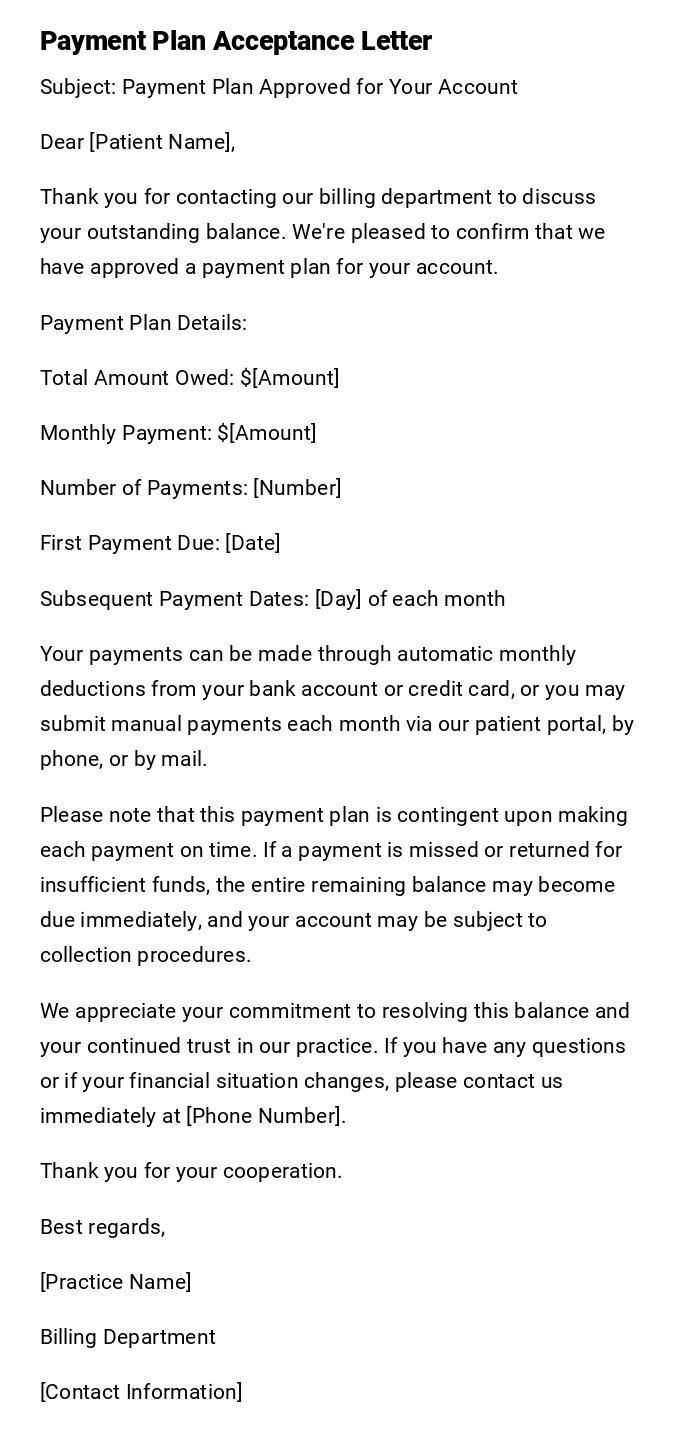
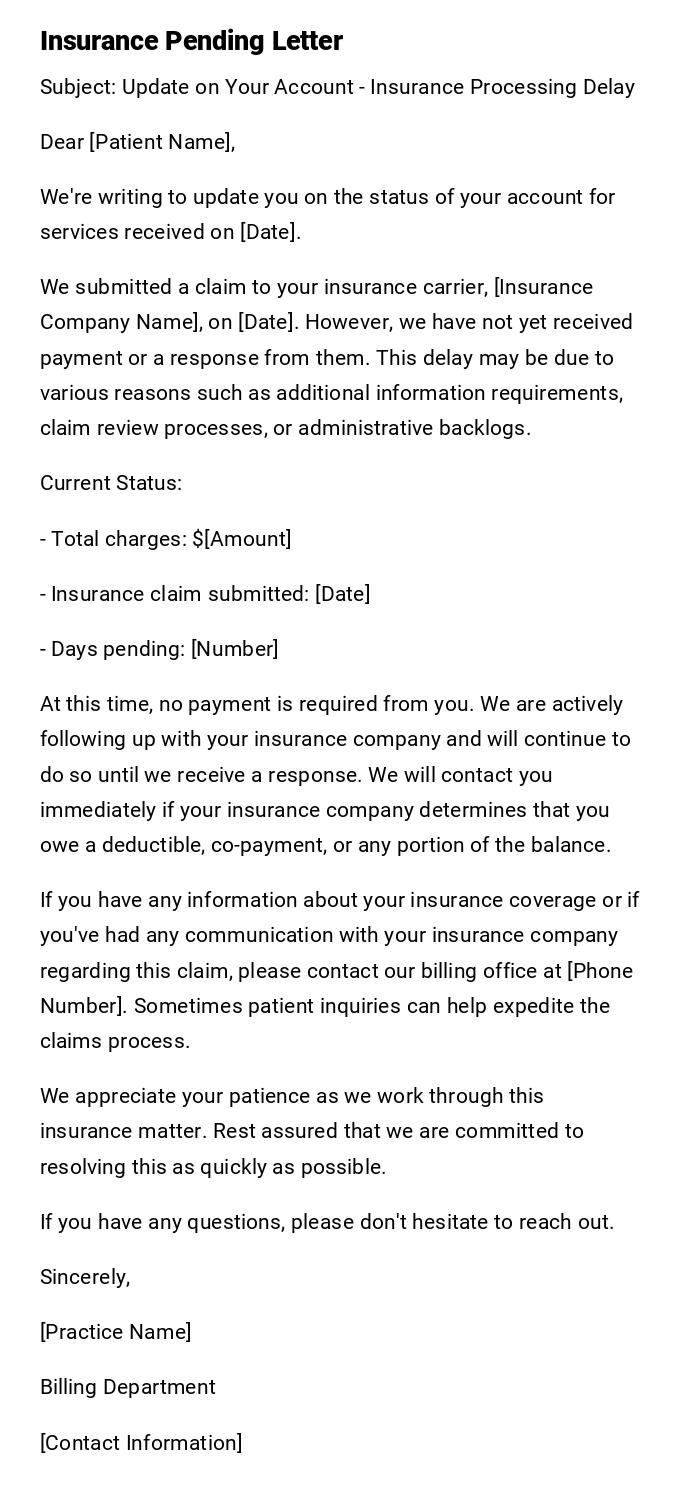
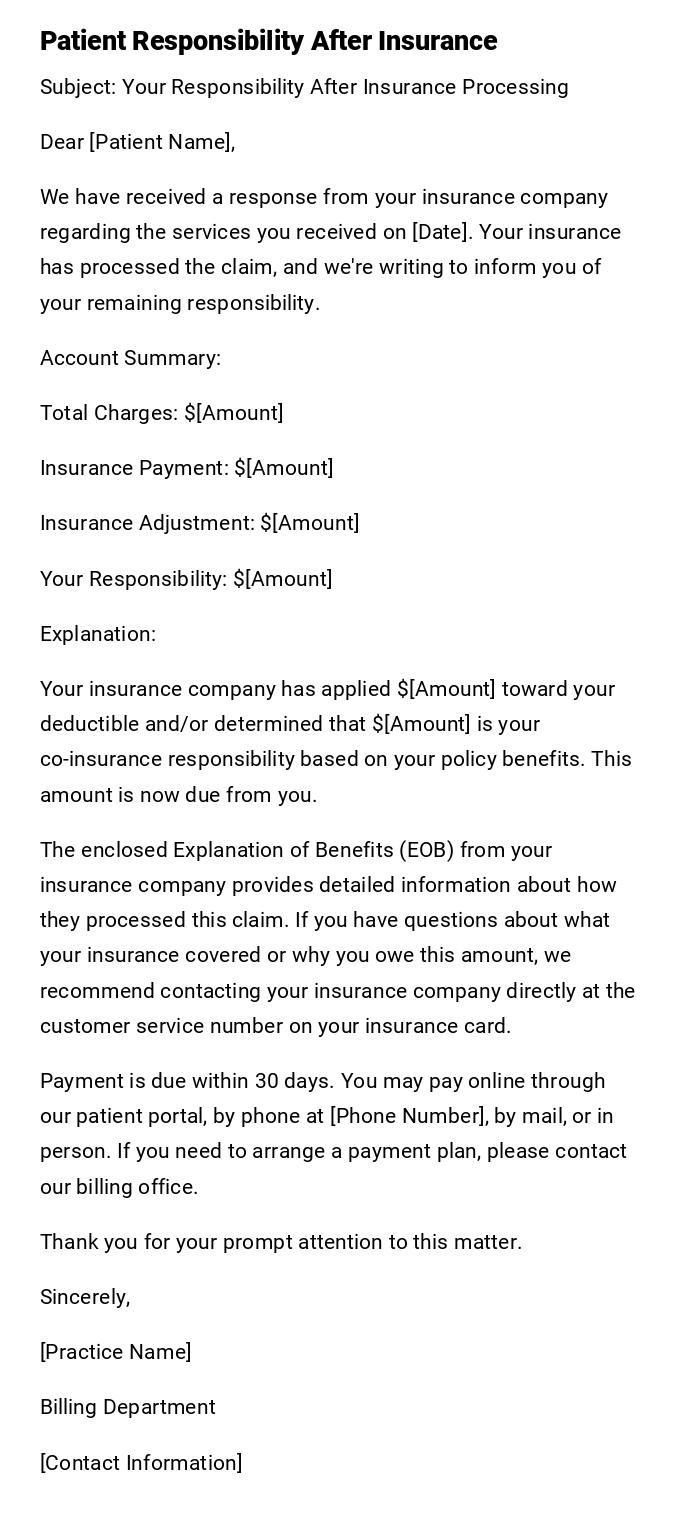
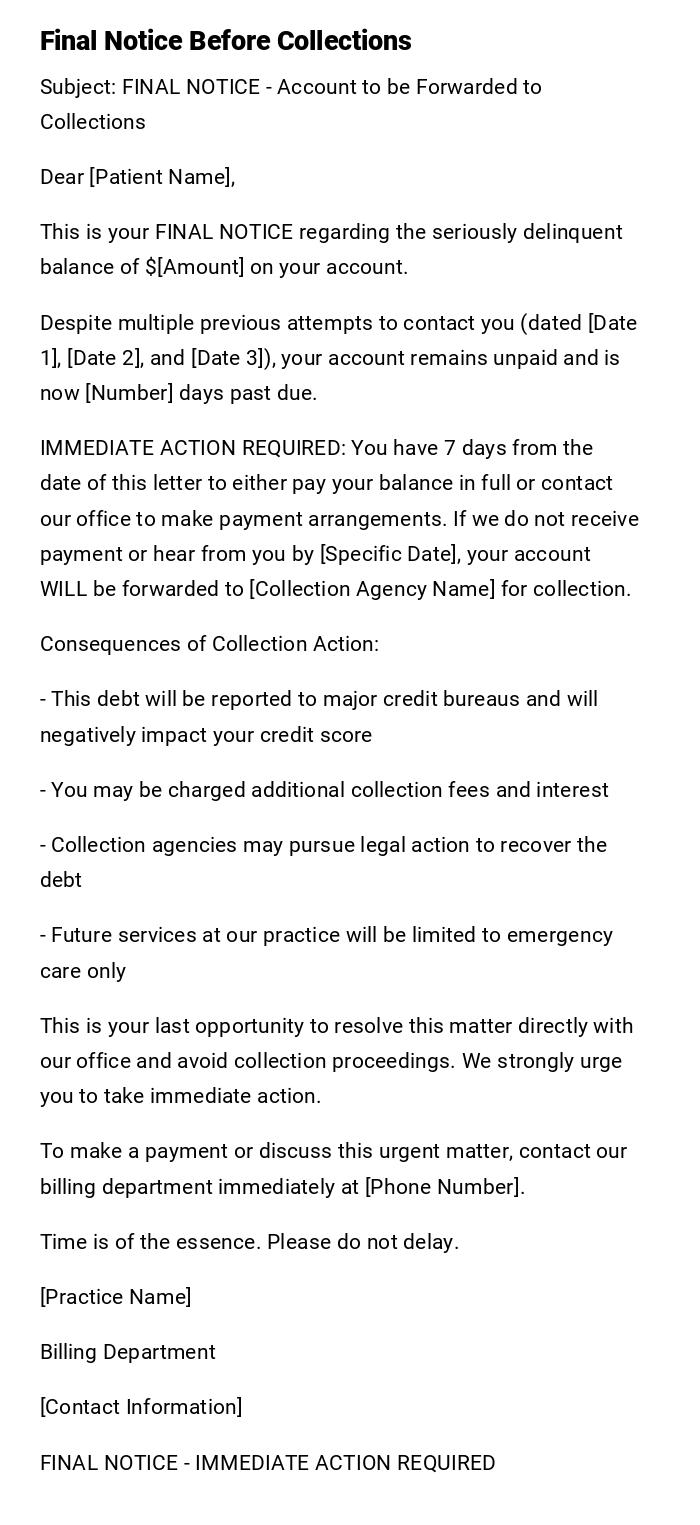
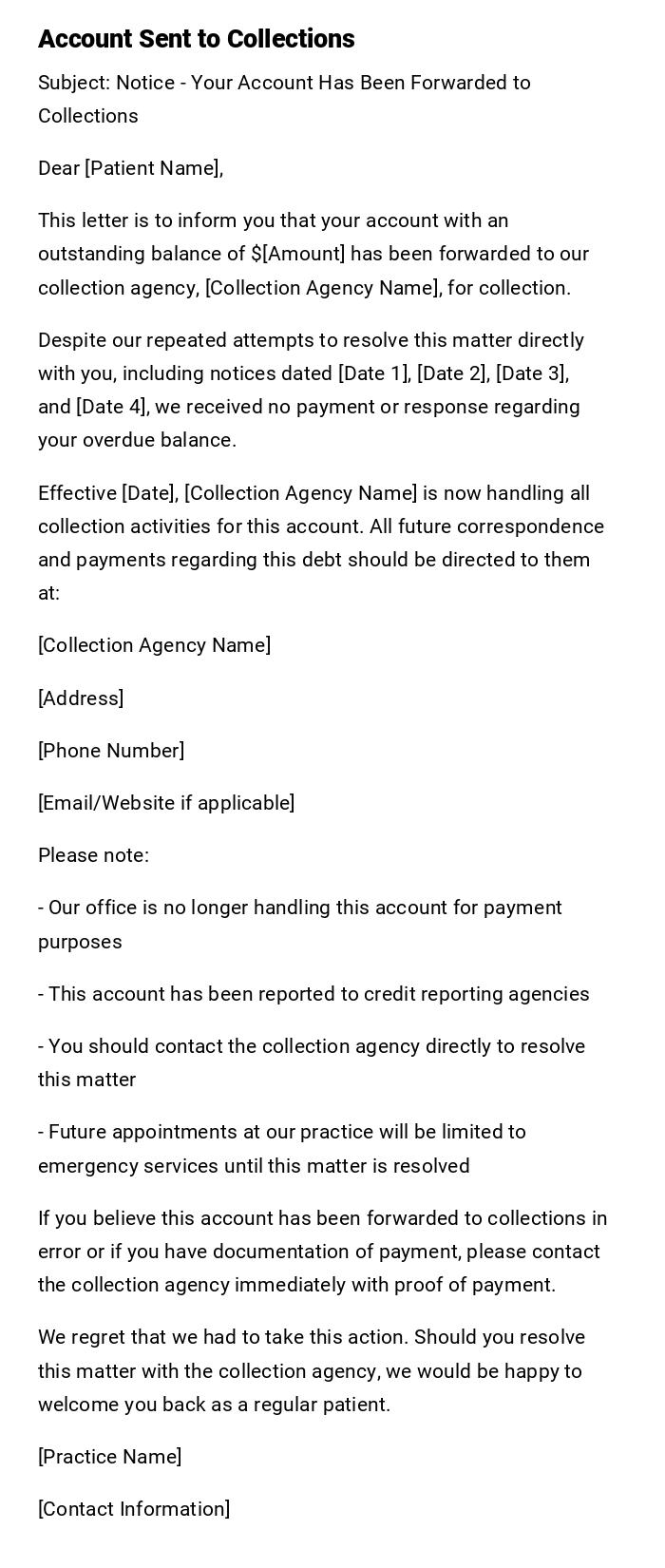

 Download Word Doc
Download Word Doc
 Download PDF
Download PDF